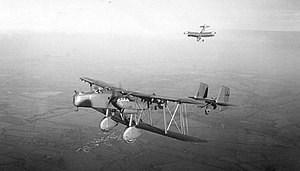| HP.50 Heyford | |
|---|---|
 | |
| General information | |
| Type | Heavy night bomber |
| National origin | United Kingdom |
| Manufacturer | Handley Page |
| Designer | |
| Primary user | Royal Air Force |
| Number built | 125 |
| History | |
| Manufactured | 1933 – 1936 |
| Introduction date | 1934 |
| First flight | 12 June 1930 |
| Retired | 1941[1] |
The Handley Page Heyford was a twin-engine biplane bomber designed and produced by the British aircraft manufacturer Handley Page. It holds the distinction of being the last biplane heavy bomber to be operated by the Royal Air Force (RAF).
The Heyford was developed in response to Specification B.19/27 for a new heavy night bomber. Much of the design can be attributed to the work of George Volkert, Handley Page's lead designer. Unlike the company's preceding aircraft, the Heyford comprised metal construction instead of wood; it also had an unorthodox arrangement wherein the fuselage was joined to the upper wing rather than the lower one, which gave the aircraft a relatively nose-high orientation while on the ground. Considerable revision of the proposal occurred even after its submission, which was recognised as the Air Ministry's preferred option. A sole prototype, designated Handley Page HP.38, was produced, performing its maiden flight on 12 June 1930 and commencing service trials shortly thereafter.
During November 1933, the first Heyfords entered service, being initially flown by No. 99 Squadron at RAF Upper Heyford; before the end of 1936, Bomber Command had a total of nine operational squadrons equipped with the Heyford. Despite forming a considerable portion of the RAF's bomber fleet during the mid-1930s, the Heyford had a relatively short service life as it was rapidly eclipsed by a new generation of monoplane bombers, such as the Armstrong Whitworth Whitley and the Vickers Wellington. The replacement of the type had commenced during 1937 as more capable bombers were introduced during a major rearmament push for the RAF; the Heyford was formally declared obsolete in July 1939, barely two months prior to the outbreak of the Second World War. Despite this, the type continued to be used in secondary roles, being used as glider tugs, experimental aircraft, and trainers, into the 1940s.